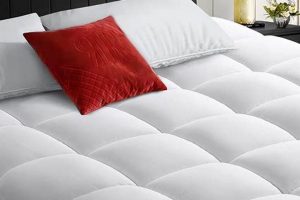A device designed to regulate bed temperature through the circulation of heated liquid, typically water. These pads are placed directly beneath the user and above the mattress, offering a consistent and controllable thermal environment for sleep. For example, individuals experiencing night sweats or those residing in colder climates may find this temperature regulation beneficial.
The significance of these devices stems from their ability to enhance sleep quality. By maintaining a stable temperature, they can reduce nighttime disturbances caused by fluctuations in body heat or ambient conditions. Historically, alternative methods such as electric blankets have been used for similar purposes; however, circulating liquid systems offer a more even distribution of warmth and eliminate concerns associated with electromagnetic fields.
The subsequent sections will delve into the operational mechanisms, features, advantages, potential drawbacks, and considerations for selecting such a product, providing a well-rounded perspective for the prospective user.
Tips for Optimal Use
Maximizing the benefits of a temperature-controlled sleep environment requires careful consideration of several factors. The following tips provide guidance for ensuring safe, effective, and comfortable operation.
Tip 1: Water Quality Maintenance: Regularly drain and refill the system with distilled water to prevent mineral buildup and maintain optimal performance. Periodic cleaning with a diluted vinegar solution can further extend the lifespan of the device.
Tip 2: Temperature Calibration: Experiment with the temperature settings to determine the ideal level for individual comfort. Gradual adjustments are recommended to avoid overheating or insufficient warmth.
Tip 3: Secure Hose Connections: Routinely inspect the hose connections for leaks or damage. Ensure that all connections are properly secured to prevent water spillage and potential electrical hazards.
Tip 4: Mattress Compatibility: Verify compatibility with the existing mattress type. Certain materials may insulate heat differently, affecting the overall effectiveness of the system.
Tip 5: Placement and Support: Position the control unit on a stable, level surface away from potential obstructions. Adequate ventilation around the unit is crucial for preventing overheating.
Tip 6: Understand the Safety Features: Familiarize with safety shut-off features, such as automatic overheating protection. Ensure these are functioning correctly before each use.
Tip 7: Regular Cleaning: Clean the surface of the pad regularly according to the manufacturer’s instructions. This will maintain hygiene and prevent the growth of mold or bacteria.
Adhering to these recommendations will promote longevity, enhance user safety, and ensure the consistent delivery of the intended therapeutic benefits. Prioritizing proper maintenance and informed operation maximizes the value of this technology.
The concluding section will provide a summary of the key points discussed and offer final thoughts on incorporating this technology into a sleep hygiene routine.
1. Temperature Regulation Precision
Temperature regulation precision is a core functional aspect of a water heated mattress pad. The degree to which the device can maintain a user-selected temperature directly impacts sleep quality and therapeutic benefits. Inconsistent or inaccurate temperature control can negate the intended advantages, leading to discomfort, disrupted sleep patterns, and diminished therapeutic value. For instance, if the device fluctuates significantly from the set temperature, individuals may experience night sweats or chills, defeating the purpose of temperature-regulated sleep. The effectiveness of the pad in addressing conditions such as arthritis-related pain relies heavily on the stability and accuracy of its temperature output.
The practical significance of precise temperature control extends to energy efficiency and safety. Well-regulated systems minimize energy waste by avoiding unnecessary heating or cooling cycles. Furthermore, consistent temperature control helps prevent overheating, a potential safety hazard. Advanced models incorporate sensors and algorithms to maintain stable temperatures while compensating for external factors such as room temperature variations and individual body heat. The ability to reliably maintain a specific temperature within a narrow range (+/- 1-2 degrees Fahrenheit) distinguishes high-quality water heated mattress pads from less sophisticated alternatives.
In summary, temperature regulation precision is not merely a desirable feature but an essential component of a water heated mattress pad. Its impact extends beyond user comfort to encompass therapeutic efficacy, energy efficiency, and safety. Accurately controlling and maintaining the specified temperature enables the device to achieve its intended purpose of providing a consistently comfortable and therapeutic sleep environment, solidifying its value proposition. The challenges involve balancing precise temperature regulation with system responsiveness and minimizing energy consumption.
2. Consistent Heat Distribution
Consistent heat distribution represents a critical functional parameter for a water heated mattress pad. The underlying principle relies on the uniform circulation of heated liquid throughout the pad’s internal network. If heating is localized or uneven, the user experiences discomfort, diminished therapeutic benefits, and potentially compromised sleep quality. For instance, cold spots within the pad would counteract its intended purpose, making it ineffective for individuals seeking relief from conditions such as fibromyalgia or arthritis, where consistent warmth is paramount. Such inconsistencies negate the rationale for utilizing the device over alternative heating methods, such as electric blankets, that, while potentially uneven, offer lower upfront costs.
The importance of uniform heat stems from its direct influence on physiological responses. Consistent warmth promotes vasodilation, increasing blood flow to peripheral tissues and facilitating muscle relaxation. Conversely, localized cold patches can induce vasoconstriction, leading to muscle tension and discomfort. Furthermore, inconsistent heat distribution can trigger the body’s thermoregulatory mechanisms, leading to disruptions in sleep stages and overall sleep architecture. Practical applications of this understanding include design considerations aimed at optimizing water flow pathways, material selection to enhance heat conduction, and the implementation of advanced control algorithms to compensate for external temperature gradients. Manufacturers achieve this through intricate internal channel designs and the use of thermally conductive materials within t
he pad’s construction.
In summary, consistent heat distribution is not merely a desirable attribute but a fundamental requirement for a water heated mattress pad to deliver its intended benefits. It directly impacts user comfort, therapeutic efficacy, and overall sleep quality. Achieving this requires careful engineering, appropriate material selection, and sophisticated temperature control mechanisms. The challenge lies in maintaining consistent heat distribution across the entire surface area of the pad while minimizing energy consumption and ensuring user safety. Proper design and implementation of these features transform the mattress pad from a simple heating device to a therapeutic tool.
3. Water Circulation System
The water circulation system forms the functional core of a water heated mattress pad. This closed-loop mechanism is responsible for transferring thermal energy from a heating unit to the mattress pad surface, thereby providing consistent and controllable warmth. Disruptions or inefficiencies within this system directly compromise the mattress pad’s primary function. For example, a malfunctioning pump can lead to inadequate or uneven heating, rendering the device ineffective for therapeutic purposes or comfort enhancement. The system’s effectiveness dictates the distribution, consistency, and reliability of the pad’s heating capabilities. Without a properly functioning water circulation system, the water heated mattress pad is reduced to a mere fabric layer lacking its intended function.
The design and implementation of the water circulation system significantly influence the device’s performance. Factors such as pump capacity, hose diameter, and internal channel configuration within the pad affect water flow rates and heat distribution. Systems employing low-flow pumps may result in temperature gradients across the pad’s surface. Conversely, systems with poorly designed channels can create localized hot spots or areas of insufficient heating. Advanced systems utilize sensors and feedback loops to dynamically adjust pump speed and heating element output, optimizing heat distribution and maintaining a stable temperature. Leaks within the circulation system represent a significant safety hazard, potentially causing electrical shorts and posing a risk of water damage to surrounding furnishings. Therefore, robust construction and leak-proof connections are paramount design considerations.
In summary, the water circulation system is an indispensable component of a water heated mattress pad, directly impacting its performance, safety, and overall effectiveness. Its design and functionality must be carefully considered to ensure consistent and reliable heat distribution. Challenges associated with system optimization include minimizing noise, maximizing energy efficiency, and maintaining long-term reliability. The effectiveness of the water circulation system is paramount to the product’s intended use, bridging the gap between conceptual design and practical application.
4. Material Composition Impact
The constituent materials of a water heated mattress pad significantly influence its performance, safety, and longevity. The selection of fabrics, internal components, and insulation directly affects heat distribution, energy efficiency, and user comfort. The following outlines key aspects of this influence.
- Surface Fabric Thermal Conductivity
The material in direct contact with the user dictates initial heat transfer. High thermal conductivity fabrics, such as certain synthetic blends, facilitate rapid heat transmission. Conversely, denser natural fibers like thick cotton may impede initial heat flow, creating a slower, more gradual warming effect. This impacts perceived comfort and the device’s responsiveness to temperature adjustments.
- Internal Layer Insulation Properties
Insulating layers within the pad minimize heat loss to the mattress below, maximizing energy efficiency and ensuring consistent temperature maintenance. Materials with high R-values, like closed-cell foams, reduce conductive heat transfer. The effectiveness of this insulation determines the energy required to maintain the set temperature and prevent heat dissipation into the underlying mattress.
- Hose Material Durability and Flexibility
The hoses transporting heated water must withstand continuous exposure to elevated temperatures and mechanical stress. Materials like reinforced silicone offer superior durability and flexibility compared to less robust alternatives such as standard PVC. Hose degradation can lead to leaks, compromising safety and functionality, while inflexible hoses can hinder device placement and usability.
- Heating Element Encapsulation
The material encasing the heating element within the control unit must provide electrical insulation and thermal conductivity to efficiently transfer heat to the circulating water. Materials such as ceramic or specialized polymers offer optimal balance between electrical safety and heat transfer efficiency. Inadequate encapsulation can result in uneven heating, reduced lifespan of the heating element, and potential electrical hazards.
In conclusion, material composition is a critical determinant of a water heated mattress pad’s overall performance and safety profile. Careful selection and integration of materials with appropriate thermal, mechanical, and electrical properties are essential for optimizing user comfort, energy efficiency, and product longevity. Compromises in material selection can lead to diminished functionality, increased energy consumption, and potential safety risks, underscoring the importance of informed design considerations.
5. Safety Mechanism Reliability
Safety mechanism reliability is paramount in the design and operation of a device utilizing both water and electricity in close proximity to a sleeping individual. Due to the inherent risks associated with combining these elements, the dependability of safety features is not merely desirable but essential for mitigating potential hazards.
- Overheat Protection Systems
These systems, often employing thermal sensors and automatic shut-off mechanisms, are designed to prevent the water from reaching dangerously high temperatures. A failure in this system could result in scalding, burns, or even fire. Real-world examples of product recalls due to faulty thermostats underscore the critical importance of robust and redundant overheat protection measures.
- Leak Detection and Prevention
Water leaks pose a significant risk of electrical shock and damage to property. Reliable leak detection systems, utilizing moisture sensors and automatic shut-off features, are crucial for minimizing these risks. The effectiveness of these systems depends on the sensitivity of the sensors and the speed of the shut-off mechanism. Incidents involving damaged or improperly sealed water reservoirs highlight the need for proactive leak prevention measures in design and manufacturing.
- Electrical Grounding and Insulation
Proper grounding and insulation are fundamental to preventing electrical shock hazards. Faulty wiring or inadequate insulation can create a pathway for electrical current to flow through the water or the user’s body. Regular testing and certification by recognized safety standards organizations are essential for ensuring the integrity of the electrical components and the effectiveness of the grounding system.
- Low Water Level Shut-Off
Operation with insufficient water levels can cause the heating element to overheat and potentially fail, posing a fire hazard. A reliable low water level shut-off mechanism prevents the device from operating when the water level is below a safe threshold. This feature safeguards the heating element and reduces the risk of fire or other malfunctions due to dry operation.
The aforementioned safety mechanisms represent critical safeguards against potential hazards associated with water heated mattress pads. Their reliability is directly correlated with user safety and product longevity. Consistent testing, adherence to safety standards, and robust design are essential for ensuring the effective operation of these safety features, thereby minimizing risks and maximizing the benefits of this technology.
6. Energy Consumption Efficiency
The operational costs and environmental impact of a water heated mattress pad are directly proportional to its energy consumption efficiency. Inefficient energy usage translates to higher electricity bills for the consumer and a larger carbon footprint. The relationship is causal: a poorly designed or maintained heating system requires more energy to achieve and sustain a desired temperature. Therefore, energy efficiency is not a peripheral concern but an essential performance metric for this class of product. A higher energy demand not only impacts household expenses but also places a greater strain on energy resources, contributing to environmental concerns. For example, a poorly insulated water heated mattress pad might require significantly more power to maintain a stable temperature compared to a well-designed unit, especially in colder climates.
The practical significance of understanding energy consumption efficiency extends to product selection and usage habits. Consumers seeking to minimize energy costs should prioritize models with high energy efficiency ratings and features like programmable timers or automatic shut-off functions. Proper maintenance, such as regular cleaning and water replacement, can also improve energy efficiency by preventing mineral build-up that impedes heat transfer. Furthermore, users should avoid setting excessively high temperatures, as this increases energy consumption without necessarily improving sleep quality. Comparative analyses of different models have demonstrated considerable variations in energy usage, highlighting the importance of informed decision-making.
In summary, energy consumption efficiency is a critical consideration for water heated mattress pads, impacting both economic and environmental sustainability. Manufacturers face the challenge of balancing heating performance with energy efficiency. Consumers benefit from understanding and prioritizing energy-efficient models, coupled with responsible usage practices. Ultimately, a focus on energy efficiency contributes to reduced operating costs and a diminished environmental impact, ensuring a more sustainable approach to personal comfort and sleep enhancement.
7. Maintenance Requirements Simplicity
The practical appeal of a water heated mattress pad is significantly influenced by the simplicity of its maintenance requirements. The device’s design inherently combines water and electricity, necessitating routine upkeep to ensure safe and efficient operation. Complicated or time-consuming maintenance procedures directly detract from user satisfaction and increase the likelihood of neglect, potentially leading to equipment failure or safety hazards. A device requiring frequent disassembly for cleaning, for instance, may deter users, leading to mineral buildup and reduced heating performance. In contrast, a system designed with easily accessible components and clear maintenance instructions promotes proactive care and extends the product’s lifespan. Cause-and-effect is evident: complex maintenance translates to user avoidance, resulting in diminished product performance and safety. A simpler routine encourages consistent upkeep, maximizing the investment and minimizing risks.
Real-life examples underscore the importance of this design consideration. Early models of these pads often featured intricate filling and draining procedures, making water replacement a cumbersome task. This resulted in users neglecting water changes, leading to mineral deposits that clogged the system and impaired heating efficiency. Newer designs have addressed this issue by incorporating easily accessible fill ports and simplified draining mechanisms. These improvements have demonstrably increased user compliance with recommended maintenance schedules, resulting in improved product longevity and fewer reported malfunctions. Manufacturers recognize that ease of maintenance directly impacts product perception and long-term customer satisfaction. User-friendly maintenance protocols are as vital as the initial product design in determining its overall success.
In summary, simplicity in maintenance requirements is a crucial determinant of a water heated mattress pad’s overall value and long-term functionality. Products designed with straightforward cleaning, filling, and draining procedures are more likely to be properly maintained, leading to enhanced performance, increased safety, and extended lifespan. The challenge for manufacturers lies in balancing complex technological features with user-friendly maintenance protocols. Prioritizing simplicity in maintenance is not merely a design choice but a fundamental requirement for ensuring sustained user satisfaction and maximizing the benefits of this sleep-enhancing technology.
Frequently Asked Questions
The following addresses common inquiries regarding water heated mattress pads. The intention is to provide clear and factual information.
Question 1: Are water heated mattress pads safe for long-term use?
Provided the device adheres to established safety standards and is maintained according to manufacturer instructions, long-term use is generally considered safe. Key safety features include overheat protection, leak detection, and proper electrical grounding. Regular inspection and maintenance are essential.
Question 2: How does a water heated mattress pad differ from an electric blanket?
A water heated mattress pad utilizes circulating warm water to regulate temperature, providing consistent and even heat distribution. Electric blankets, on the other hand, use electrical resistance wires. The former is often perceived as offering more uniform warmth and eliminating concerns related to electromagnetic fields, whereas the latter is cheaper and more portable.
Question 3: What are the typical maintenance requirements?
Maintenance generally involves periodically draining and refilling the system with distilled water to prevent mineral buildup. Cleaning the pad’s surface and inspecting hose connections for leaks are also recommended. Re
fer to the manufacturer’s guidelines for specific maintenance procedures and intervals.
Question 4: Can a water heated mattress pad be used with any type of mattress?
Most water heated mattress pads are compatible with a variety of mattress types. However, it is advisable to verify compatibility with memory foam mattresses or those with specialized materials, as these may affect heat distribution. Consult the mattress and pad manufacturers’ guidelines.
Question 5: What is the typical lifespan of a water heated mattress pad?
The lifespan can vary significantly depending on the quality of materials, usage frequency, and adherence to maintenance guidelines. Generally, a well-maintained, high-quality unit can last for several years. Warranties offered by manufacturers provide an indication of expected product durability.
Question 6: Are there any potential health concerns associated with using a water heated mattress pad?
Potential concerns include overheating, which can disrupt sleep. Individuals with certain medical conditions, such as peripheral neuropathy or diabetes, should consult with a healthcare professional before using a water heated mattress pad, as they may have reduced sensitivity to temperature changes.
These FAQs provide a basic understanding of water heated mattress pads. Always consult the manufacturer’s instructions and safety guidelines for specific information.
The subsequent discussion will address user reviews and testimonials, offering insights from real-world experiences.
Conclusion
The preceding analysis has explored the multifaceted aspects of the water heated mattress pad. From its operational mechanism and temperature regulation precision to energy consumption efficiency and safety mechanism reliability, the discussion has underscored the importance of understanding the technology’s capabilities and limitations. Key considerations include material composition, water circulation effectiveness, and the simplicity of required maintenance procedures. These elements collectively determine the device’s performance, safety profile, and long-term value proposition.
Prospective users are encouraged to weigh these factors carefully when evaluating product options, prioritizing models that align with individual needs and safety requirements. The responsible adoption of this technology, grounded in informed decision-making, can contribute to enhanced sleep quality and improved overall well-being. Future advancements in material science and temperature control algorithms hold the potential to further optimize the performance and sustainability of water heated mattress pad technology. Further research may validate and highlight other potential benefits from it.


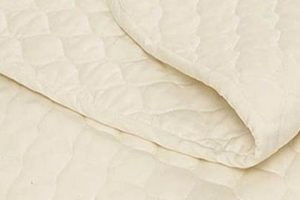
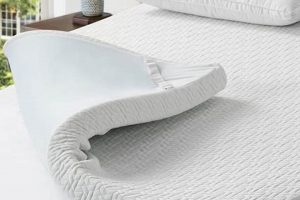
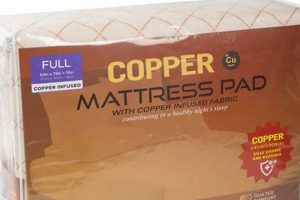
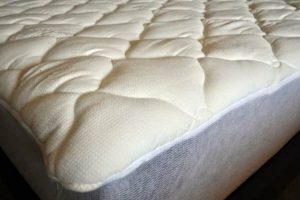
![Top Rated: Best Mattress Pad for Back Pain Relief [Guide] Organic & Natural Mattress Buyer’s Guide: Non-Toxic Sleep Solutions Top Rated: Best Mattress Pad for Back Pain Relief [Guide] | Organic & Natural Mattress Buyer’s Guide: Non-Toxic Sleep Solutions](https://mattressworldpa.com/wp-content/uploads/2025/07/th-4688-300x200.jpg)
